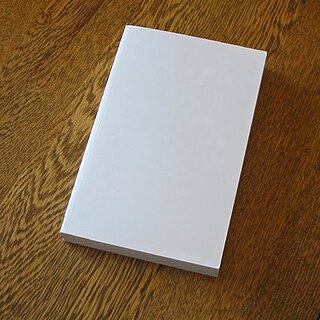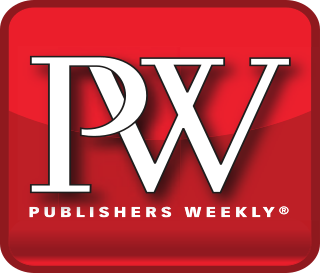
A book is a medium for recording information in the form of writing or images, typically composed of many pages bound together and protected by a cover. It can also be a handwritten or printed work of fiction or nonfiction, usually on sheets of paper fastened or bound together within covers. The technical term for this physical arrangement is codex. In the history of hand-held physical supports for extended written compositions or records, the codex replaces its predecessor, the scroll. A single sheet in a codex is a leaf and each side of a leaf is a page.
The New York Times Best Seller list is widely considered the preeminent list of best-selling books in the United States. Since October 12, 1931, The New York Times Book Review has published the list weekly. In the 21st century, it has evolved into multiple lists, grouped by genre and format, including fiction and nonfiction, hardcover, paperback and electronic.

Print on demand (POD) is a printing technology and business process in which book copies are not printed until the company receives an order, allowing prints in single or small quantities. While other industries established the build-to-order business model, POD could only develop after the beginning of digital printing because it was not economical to print single copies using traditional printing technologies such as letterpress and offset printing.

A paperback book is one with a thick paper or paperboard cover, and often held together with glue rather than stitches or staples. In contrast, hardcover (hardback) books are bound with cardboard covered with cloth, leather, paper, or plastic.
A vanity press or vanity publisher, sometimes also subsidy publisher, is a publishing house where the author pays to have the book published, and signs a restrictive contract which involves surrendering significant rights. It is not to be confused with hybrid publishing, or assisted self-publishing.

Ballantine Books is a major American book publisher that is a subsidiary of German media conglomerate Bertelsmann. Ballantine was founded in 1952 by Ian Ballantine with his wife, Betty Ballantine. Ballantine was acquired by Random House in 1973, which in turn was acquired by Bertelsmann in 1998 and remains part of that company.

Penguin Books Limited is a British publishing house. It was co-founded in 1935 by Allen Lane with his brothers Richard and John, as a line of the publishers The Bodley Head, only becoming a separate company the following year. Penguin revolutionised publishing in the 1930s through its inexpensive paperbacks, sold through Woolworths and other stores for sixpence, bringing high-quality fiction and non-fiction to the mass market. Its success showed that large audiences existed for serious books. It also affected modern British popular culture significantly through its books concerning politics, the arts, and science.

Tauchnitz was the name of a family of German printers and publishers. They published English language literature for distribution on the European continent outside Great Britain, including initial serial publications of novels by Charles Dickens. Though copyright protection did not exist between nations in the 19th century, Tauchnitz paid the authors for the works they published, and agreed to limit their sales of English-language books to the European continent, as authors like Dickens or Bulwer-Lytton had separate arrangements for publication and sale in Great Britain.

Publishers Weekly (PW) is an American weekly trade news magazine targeted at publishers, librarians, booksellers, and literary agents. Published continuously since 1872, it has carried the tagline, "The International News Magazine of Book Publishing and Bookselling". With 51 issues a year, the emphasis today is on book reviews.

Dodd, Mead and Company was one of the pioneer publishing houses of the United States, based in New York City. Under several names, the firm operated from 1839 until 1990.
Harvey Elliott Klehr is a professor of politics and history at Emory University. Klehr is known for his books on the subject of the American Communist movement, and on Soviet espionage in America.

Street & Smith or Street & Smith Publications, Inc., was a New York City publisher specializing in inexpensive paperbacks and magazines referred to as dime novels and pulp fiction. They also published comic books and sporting yearbooks. Among their many titles was the science fiction pulp magazine Astounding Stories, acquired from Clayton Magazines in 1933, and retained until 1961. Street & Smith was founded in 1855, and was bought out in 1959. The Street & Smith headquarters were at 79 Seventh Avenue in Manhattan; they were designed by Henry F. Kilburn.
The Eastern Color Printing Company was a company that published comic books, beginning in 1933. At first, it was only newspaper comic strip reprints, but later on, original material was published. Eastern Color Printing was incorporated in 1928, and soon became successful by printing color newspaper sections for several New England and New York papers. Eastern is most notable for its production of Funnies on Parade and Famous Funnies, two publications that gave birth to the American comic book industry.

Dell Publishing Company, Inc. is an American publisher of books, magazines and comic books, that was founded in 1921 by George T. Delacorte Jr. with $10,000, two employees and one magazine title, I Confess, and soon began turning out dozens of pulp magazines, which included penny-a-word detective stories, articles about films, and romance books.

The Complete Directory to Prime Time Network and Cable TV Shows, 1946–Present is a trade paperback reference work by the American television historians Tim Brooks and Earle Marsh, first published by Ballantine Books in 1979.

Matthew Stadler is an American author who has written six novels and received several awards. Stadler has compiled four anthologies about literature, city life and public life. His essays, which have been published in magazines and museum catalogs, focus on architecture, urban planning and sprawl.

African American newspapers are news publications in the United States serving African American communities. Samuel Cornish and John Brown Russwurm started the first African American periodical, Freedom's Journal, in 1827. During the Antebellum South, other African American newspapers sprang up, such as The North Star, founded in 1847 by Frederick Douglass.

The University of New Mexico Press (UNMP) is a university press at the University of New Mexico. It was founded in 1929 and published pamphlets for the university in its early years before expanding into quarterlies and books. Its administrative offices are in the Office of Research, on the campus of UNM in Albuquerque.

Western comics is a comics genre usually depicting the American Old West frontier and typically set during the late nineteenth century. The term is generally associated with an American comic books genre published from the late 1940s through the 1950s. Western comics of the period typically featured dramatic scripts about cowboys, gunfighters, lawmen, bounty hunters, outlaws, and Native Americans. Accompanying artwork depicted a rural America populated with such iconic images as guns, cowboy hats, vests, horses, saloons, ranches, and deserts, contemporaneous with the setting.

Trump: The Art of the Deal is a 1987 book credited to Donald J. Trump and journalist Tony Schwartz. Part memoir and part business-advice book, it was the first book credited to Trump, and helped to make him a household name. It reached number 1 on The New York Times Best Seller list, stayed there for 13 weeks, and altogether held a position on the list for 48 weeks. Trump cited it as one of his proudest accomplishments and his second-favorite book after the Bible.















